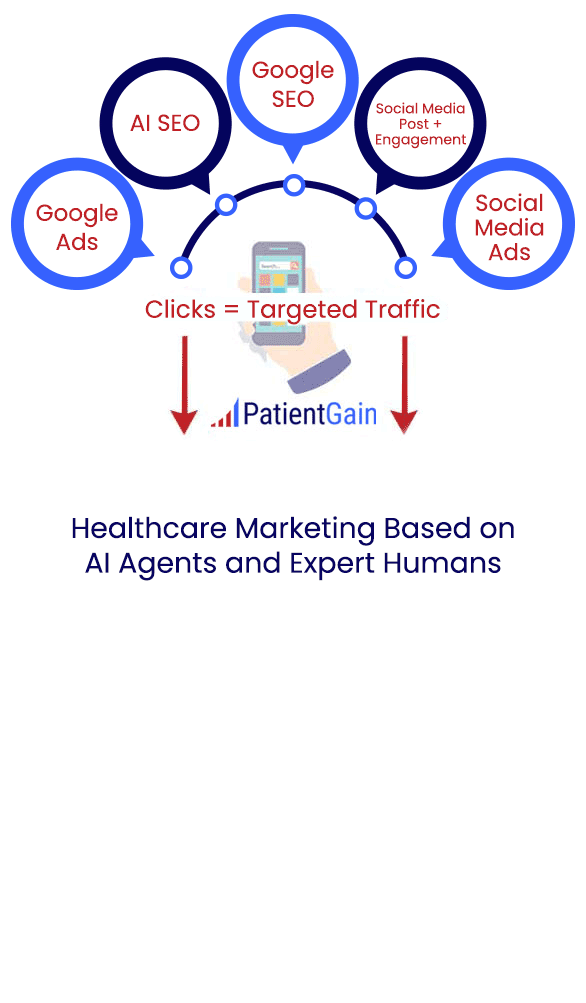Best Website Builder for Medical Practice
What are key strategies used by the top website builders for medical practices in US?
When building a website for a medical practice, the best website builders use a combination of strategies that prioritize patient experience, regulatory compliance, security, and performance optimization. In addition to these core strategies, A/B testing and HIPAA compliance are essential to ensure that the website not only performs well but also meets all legal and security requirements.
Partnering with a HIPAA-compliant platform like PatientGain.com ensures that your medical practice’s website adheres to the highest standards of data security and privacy. By implementing secure infrastructure, role-based access, and comprehensive staff training, PatientGain helps protect patient information and maintain compliance with HIPAA regulations.
The “best website builder” for a medical practice is not a DIY tool like Wix, WordPress or Squarespace, but rather a professional service or platform that employs a set of highly specialized strategies. These strategies are designed to create a digital asset that not only looks professional but functions as a practice’s primary patient acquisition engine, all while operating within a strict federal regulatory framework, like HIPAA.

For building a HIPAA-compliant website, the “best” choice depends on your organization’s specific needs (e.g., a simple private practice website vs. a complex data-driven portal). General-purpose builders like Wix and Squarespace are NOT inherently HIPAA compliant.
Purpose-built, HIPAA-first platforms offer a more streamlined path to compliance.
Top HIPAA-Compliant Website Builders & Platforms
| Platform | Best For | Key Features | Pricing Model |
|---|---|---|---|
| Blaze.tech | Overall, no-code, and ease of use | End-to-end encryption, audit logs, no-code builder, BAA provided | Starts around $400/month |
| PatientGain | Medical/dental practices needing marketing solutions | HIPAA-compliant websites and CRM, secure forms, marketing AI, BAA included | Starts at$799/month for fully managed services. This is a done-for-you, as opposed to D.I.Y HIPAA service |
| SimplePractice | Therapists and mental health professionals | Integrated with SimplePractice EHR, pre-generated content, BAA provided | Starts around $49/month, linked to practice management plan |
| Quickbase | Scalable websites with complex data workflows | Low-code platform, real-time analytics, robust access controls, BAA provided | Starts around $55/user/month (min 40 users) |
| Caspio | Building data-driven websites/apps | Low-code, pre-built healthcare templates (scheduling, claims), BAA provided | Starts around $900/month for the HIPAA plan |
What is considered an effective HIPAA compliant website?
An effective website for a healthcare providers like doctors, dentists, med spas – must have :
- Ability to securely transmit and save PHI data (Protected Health Information of patients)
- Attract new patients using techniques like SEO
- Provide useful information for existing patients
- Allow your practice staff to see all inquiries, questions, leads, referrals in one simple dashboard. Dashboard must be HIPAA compliant.
1. HIPAA Compliance
Ensuring that a medical website is HIPAA-compliant is a critical strategy. HIPAA (Health Insurance Portability and Accountability Act) sets the standard for protecting sensitive patient data. An intelligent website builder for medical practices should include the following elements:
- Secure Data Collection: Any patient information (e.g., personal details, medical histories) must be collected through encrypted forms. These forms should use SSL/TLS encryption to ensure the safe transmission of sensitive data.
- Secure Patient Portals: A secure patient portal where patients can access their health records, schedule appointments, and communicate with the practice securely. The portal must be HIPAA-compliant and provide robust password protection and encryption.
- Business Associate Agreements (BAAs): Medical website builders should have the capability to help medical practices enter into BAAs with third-party services that may handle PHI (Protected Health Information) on behalf of the practice, such as cloud services or marketing platforms.
- Data Storage and Protection: Patient data should be stored securely on servers that meet HIPAA standards. The website builder must ensure encrypted storage and facilitate compliance audits.
- Privacy Policy and Terms of Use: A comprehensive privacy policy and terms of use that clearly outline how the practice handles and protects patient data.
Example: Websites built using platforms like PatientGain are HIPAA-compliant, offering encryption, secure patient portals, and necessary compliance tools to ensure patient data remains protected.
2. User-Centered Design (UX/UI)
A user-friendly design ensures that patients can easily navigate the website, find the information they need, and complete key actions like booking an appointment or requesting a consultation. This is vital for both patient satisfaction and conversion rates.
- Responsive Design: A website must be mobile-friendly since many users search for healthcare providers on mobile devices. This includes optimized mobile versions of the website that load quickly and function smoothly.
- Simple Navigation: Easy-to-understand menu structures and calls to action (CTAs) like “Book Appointment,” “Contact Us,” or “Request Consultation” should be strategically placed.
- Accessibility: The website should be ADA-compliant, ensuring it is accessible to people with disabilities (e.g., screen reader compatibility, text resizing options, and color contrast for the visually impaired).
3. Conversion Rate Optimization (CRO)
A good medical website builder integrates strategies for conversion rate optimization (CRO), ensuring that visitors take desired actions like booking consultations, filling out forms, or calling the practice.
- Clear Calls to Action (CTAs): CTAs should be visible and placed prominently throughout the site (e.g., “Book Now,” “Request a Free Consultation”). PatientGain emphasizes placing CTAs in multiple locations across the website, including the homepage, service pages, and blog posts.
- Patient Testimonials and Reviews: Social proof is essential in healthcare. The best website builders help integrate patient reviews and success stories directly into the website to build trust and encourage conversions.
- Lead Capture Forms: Easy-to-use forms for capturing patient information, such as scheduling requests or inquiries. These forms should be simple to complete and integrated with the PatientGain’s CRM for follow-up.
4. A/B Testing of the website design
A/B testing involves testing two or more variations of a webpage to determine which version performs better in terms of patient engagement and conversion. The best website builders for medical practices should offer A/B testing capabilities to continuously improve the site’s performance. PatientGain’s websites offered with the PLATINUM service are A/B tested for high conversion rate.
- Testing Different Headlines: A/B testing can help determine which headline drives more appointments. For example, one version of the homepage may ask, “Looking for a Weight Loss Solution?” while another may say, “Ready to Lose Weight with Our Proven Program?”
- CTA Optimization: A/B tests can measure which call to action works best for encouraging users to schedule an appointment, download a guide, or call the practice.
- For example, testing CTAs like “Get Started Today” vs. “Schedule Your Free Consultation” can reveal which is more effective at getting visitors to convert into patients.
- Visual and Layout Tests: You can also A/B test different layouts, color schemes, images, and video content to see which design elements lead to better performance.
- Tracking Metrics: The goal of A/B testing is to measure user behavior on the website (e.g., time spent on page, click-through rate, bounce rate) and identify the best-performing strategies.
Example: If a weight loss clinic uses A/B testing for its landing page and discovers that a page with before-and-after photos leads to a higher conversion rate, they can optimize the page to feature these images more prominently across their website.
5. Medical SEO Optimization
Search Engine Optimization (SEO) for your medical website is essential for medical websites to rank higher in search engines and attract more potential patients. A good website builder includes built-in SEO tools to ensure that the practice’s website is discoverable.
- Local SEO: For medical practices, local SEO is essential. The website builder should allow for easy optimization of Google My Business listings and local search terms like “best weight loss clinic in [city]” or “plastic surgeon near me.”
- Optimized Content: The website builder should support SEO-friendly content, including meta tags, headings, and keywords specific to medical services offered.
- Mobile SEO: Mobile optimization is crucial for SEO performance, as search engines like Google prioritize mobile-friendly websites.
6. Performance and Conversion Tracking Dashboards
A reliable medical website builder will have performance monitoring dashboards and ensure that the website’s security is top-notch.
- Website Speed: Medical websites need to load quickly to prevent visitors from bouncing. The best website builders optimize image sizes, reduce server load, and improve overall website speed.
- Continuous Security: Along with HIPAA compliance, ensuring the site is protected against cyberattacks or data breaches is vital. Features such as firewalls, SSL certificates, and regular security patches help protect sensitive patient data.
7. Integration with Marketing AI Apps and HIPAA Compliant CRM
Integration with AI based marketing apps and HIPAA complaint CRM systems allows practices to streamline communication and patient acquisition processes, and increase patient conversions and improves patient satisfaction.
- CRM Integration: Sync the website with practice management and CRM software to automatically capture lead information, send follow-up emails, and track patient interactions. PatientGain’s PLATINUM service includes both a HIPAA-compliant CRM and a HIPAA-compliant website. The CRM is designed to securely store patient information, and the website is built to protect patient data and communication. PatientGain also offers a Business Associate Agreement (BAA) to its customers, which is a legal requirement for HIPAA compliance.
. - Email Marketing Automation: Medical website builders should allow seamless integration with email marketing platforms, automating appointment reminders, newsletters, and patient engagement campaigns. PatientGain’s PLATINUM service includes HIPAA compliant email marketing.
- Social Media Posting per HIPAA regulations: Social media links and integration with platforms like Instagram and Facebook help increase patient engagement and bring in more traffic to the website. PatientGain’s PLATINUM service includes social media posting app, that is designed for healthcare practices that includes social media posting capabilities that adhere to HIPAA regulations. This means they take necessary steps to ensure that patient information is protected and not disclosed improperly when creating and managing social media content. This app uses AI agents and expert humans verify the posts and then healthcare practices have access to thousands of social media posts, based on the services offered by a specific healthcare practice.
8. Engineering Unshakeable Trust with E-E-A-T
For medical websites, Google’s E-E-A-T (Experience, Expertise, Authoritativeness, Trustworthiness) guidelines are not optional. A top builder engineers these signals into the fabric of the site.
- Showcasing Real Providers: Detailed, professional bios for every physician and key practitioner are created, listing their credentials, education, board certifications, and philosophy of care.
- Authentic Social Proof: Patient testimonials, video stories, and high ratings are featured prominently. Instead of stock photos, high-quality, authentic images of the actual clinic, staff, and technology are used.
- Transparency: The website clearly explains the science behind treatments in patient-friendly language, building authority and educating the patient simultaneously.
Example: Creating a dedicated page for each physician that includes their education, board certifications, philosophy of care, and a professional video introduction.
The best website builders for medical practices use a combination of strategies to ensure the site is patient-centered, HIPAA-compliant, and SEO-optimized. The design prioritizes ease of navigation, trust, and conversion optimization to drive patient engagement and appointment bookings. By adopting best practices like A/B testing for continuous improvement and HIPAA compliance for safeguarding patient data, these builders create high-performing websites that help medical practices thrive in a competitive digital landscape. PatientGain offers this service in the monthly PLATINUM service.

